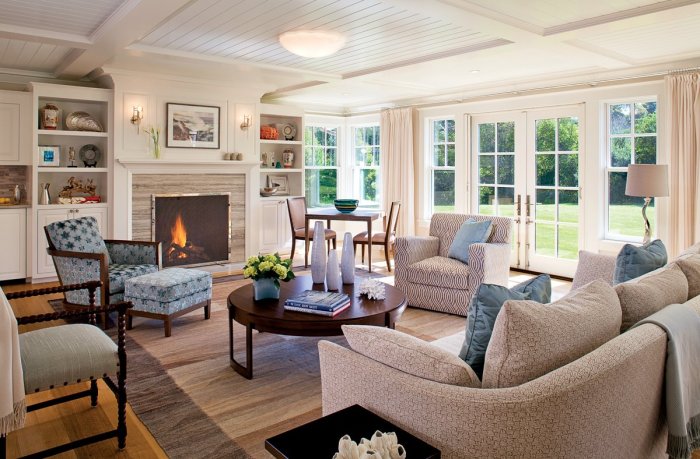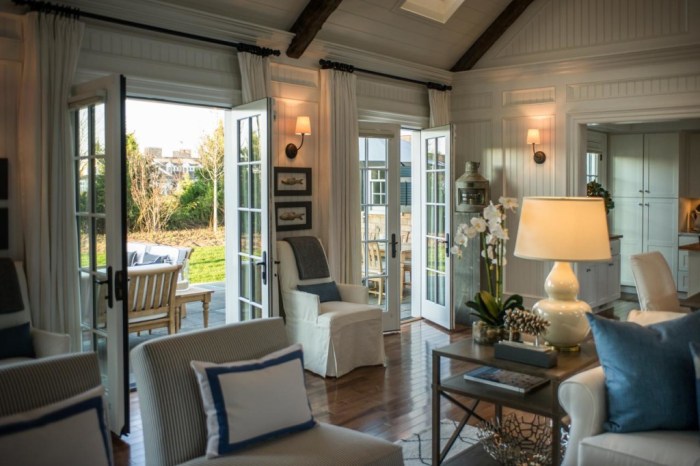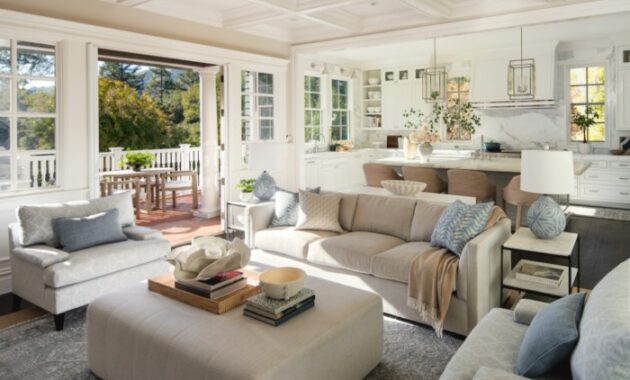Cape Cod house interior design embodies the essence of coastal living, merging practicality with a timeless elegance. From its humble origins, the Cape Cod style has evolved into a beloved architectural tradition, captivating homeowners with its charming simplicity and connection to nature.
This guide delves into the captivating world of Cape Cod interiors, offering insights into its history, design principles, and practical tips for creating a space that exudes the warmth and inviting atmosphere synonymous with the region.
Outdoor Spaces

Cape Cod homes are renowned for their connection to the natural world, and outdoor living is an integral part of the Cape Cod lifestyle. The proximity to the ocean, the abundance of natural beauty, and the long, sunny days make spending time outdoors an essential aspect of living on the Cape.
The design of outdoor spaces should complement the interior design, creating a seamless flow between the indoors and outdoors.
Designing Outdoor Spaces
Outdoor spaces in Cape Cod homes should be designed to create a comfortable and inviting atmosphere. The design should complement the interior design, creating a cohesive look and feel. Here are some ideas for creating a comfortable and inviting outdoor area:
- Create a Focal Point:A fireplace, a water feature, or a well-designed outdoor kitchen can be a focal point for your outdoor space. These elements can draw people together and create a sense of gathering and relaxation.
- Use Natural Materials:Cape Cod homes are known for their use of natural materials, and this should extend to the outdoor spaces. Stone, wood, and brick are all excellent choices for patios, walkways, and walls. These materials create a sense of warmth and connection to nature.
- Consider the View:Cape Cod is known for its beautiful scenery, so take advantage of the views from your outdoor space. Place seating areas and dining areas so that you can enjoy the ocean, the beach, or the surrounding nature.
- Add Comfortable Seating:Comfortable seating is essential for any outdoor space. Choose furniture that is weather-resistant and comfortable enough to spend time relaxing in. Consider adding cushions, throws, and pillows for extra comfort.
- Create a Sense of Privacy:While Cape Cod is known for its open spaces, you may want to create a sense of privacy in your outdoor area. You can use trees, shrubs, or fences to create a secluded space. Consider adding a pergola or an awning to provide shade and shelter from the elements.
- Incorporate Lighting:Lighting is essential for creating a welcoming atmosphere in your outdoor space. Consider using string lights, lanterns, or spotlights to illuminate your patio, deck, or garden. Lighting can also be used to highlight specific features in your outdoor space.
Sustainability and Eco-Friendly Design
Sustainability and eco-friendly design are increasingly important considerations for homeowners, especially in a coastal environment like Cape Cod. By incorporating sustainable materials and practices, you can create a beautiful and functional home that minimizes its impact on the environment.
Sustainable Materials
Sustainable materials are those that are sourced responsibly and have minimal environmental impact. Here are some examples of sustainable materials commonly used in Cape Cod interiors:
- Reclaimed wood:Reclaimed wood is a great way to add character and warmth to a home while reducing waste. It can be used for flooring, beams, furniture, and other decorative elements. Reclaimed wood often comes from old barns, factories, and other structures, giving it a unique history and a distinctive look.
Cape Cod house interior design often emphasizes a cozy and welcoming atmosphere, with light and airy spaces that evoke a sense of relaxation. While this style prioritizes functionality and simplicity, you can also draw inspiration from other cultures, such as the tranquil aesthetic of bali house interior design.
The use of natural materials, warm tones, and intricate details found in Balinese design can be subtly incorporated into a Cape Cod home, adding a touch of exotic charm without compromising the overall character.
- Bamboo:Bamboo is a fast-growing, renewable resource that is strong and durable. It can be used for flooring, furniture, and other applications. Bamboo is a sustainable choice as it requires less water and pesticides than traditional hardwoods.
- Cork:Cork is a natural, renewable material that is harvested from the bark of cork oak trees. It is a sustainable choice as it is harvested without harming the trees. Cork is often used for flooring, wall coverings, and furniture. Cork is a natural insulator and can help to improve the energy efficiency of your home.
- Wool:Wool is a natural fiber that is biodegradable and renewable. It is a good insulator and can help to regulate temperature. Wool is often used for rugs, blankets, and upholstery. Wool is also a sustainable choice as it is a byproduct of the sheep industry.
- Linoleum:Linoleum is a natural floor covering made from linseed oil, rosin, wood flour, and jute. It is a sustainable choice as it is made from renewable resources and is biodegradable. Linoleum is a durable and long-lasting flooring option.
Energy-Efficient Features
Incorporating energy-efficient features can significantly reduce your home’s energy consumption and carbon footprint. Here are some ideas for incorporating energy-efficient features into your Cape Cod home:
- High-performance windows and doors:Energy-efficient windows and doors can help to reduce heat loss in the winter and heat gain in the summer. They are typically made with multiple panes of glass, low-emissivity coatings, and gas fills. These features can help to improve the energy efficiency of your home and reduce your heating and cooling costs.
- Insulation:Proper insulation is essential for maintaining a comfortable temperature in your home year-round. It can help to reduce heat loss in the winter and heat gain in the summer. Insulation can be added to the walls, attic, and basement of your home.
- Solar panels:Solar panels can be used to generate electricity from sunlight. This can help to reduce your reliance on fossil fuels and save money on your energy bills. Solar panels are a good option for homeowners who want to reduce their carbon footprint and take advantage of renewable energy sources.
- LED lighting:LED lights are more energy-efficient than traditional incandescent bulbs. They use less energy and last longer. Switching to LED lighting can significantly reduce your energy consumption and save money on your electricity bill.
- Smart thermostats:Smart thermostats can learn your heating and cooling preferences and adjust the temperature accordingly. This can help to save energy and money on your utility bills. They also allow you to control your home’s temperature remotely.
Eco-Friendly Furniture and Decor
When choosing furniture and decor for your Cape Cod home, consider opting for eco-friendly options.
Cape Cod house interior design often embraces a classic and timeless aesthetic. A popular approach is to utilize a black and white interior design house scheme, creating a sense of sophistication and elegance. This color palette seamlessly complements the traditional architectural elements of a Cape Cod home, such as wood beams and fireplaces, resulting in a refined and inviting ambiance.
- Recycled materials:Many furniture and decor items are now made from recycled materials, such as plastic bottles, aluminum cans, and old tires. Choosing furniture made from recycled materials helps to reduce waste and conserve resources.
- Sustainable wood:Look for furniture made from sustainably harvested wood. This means that the wood comes from forests that are managed responsibly and that are not being depleted. The Forest Stewardship Council (FSC) is a non-profit organization that certifies forests that meet their standards for sustainable forestry.
- Organic fabrics:Choose furniture and decor items made from organic fabrics, such as cotton, linen, and wool. Organic fabrics are grown without the use of harmful pesticides and fertilizers, making them a more sustainable choice.
- Locally sourced items:Buying furniture and decor items from local artisans and businesses can help to support your community and reduce the environmental impact of transportation. Look for furniture made by local craftspeople or from local materials.
- Second-hand furniture:Consider buying second-hand furniture or repurposing old furniture to give it a new life. This is a great way to save money and reduce waste.
Inspiration and Resources

Finding inspiration for your Cape Cod home interior design can be an exciting and rewarding journey. From the classic charm of traditional Cape Cod homes to the modern interpretations that incorporate contemporary elements, there are endless possibilities to explore. To guide you in this process, we’ll delve into real-life examples, valuable resources, and the benefits of working with a professional designer.
Real-Life Examples
To spark your imagination, let’s explore a few real-life examples of stunning Cape Cod home interiors:
- A Classic Cape Cod Home in Chatham, Massachusetts: This home features a traditional design with exposed beams, a fireplace, and a light and airy color palette. The living room is adorned with comfortable furniture, charming nautical accents, and a collection of family heirlooms. The kitchen is a dream for any home chef, featuring a farmhouse sink, butcher block countertops, and a cozy breakfast nook.
The bedrooms are decorated with calming tones and cozy linens, creating a serene and inviting atmosphere.
- A Modern Cape Cod Home in Falmouth, Massachusetts: This home seamlessly blends contemporary design elements with the classic charm of Cape Cod architecture. The interior features clean lines, a minimalist color palette, and an abundance of natural light. The living room is a spacious and inviting space with a large sectional sofa, a statement rug, and artwork that reflects the natural beauty of the Cape.
The kitchen is a sleek and modern space with stainless steel appliances, a large island, and ample storage. The bedrooms are decorated with a focus on comfort and functionality, with built-in storage and luxurious bedding.
Online Resources
The internet is a treasure trove of inspiration for Cape Cod home design. Here are some websites and publications that offer valuable insights and stunning visuals:
- Houzz: Houzz is a popular online platform that connects homeowners with professionals and provides a vast library of design inspiration, including a dedicated section for Cape Cod style homes.
- Pinterest: Pinterest is a visual search engine that allows users to browse and save images. You can create boards dedicated to Cape Cod home design and find inspiration from countless images of real homes, furniture, and décor.
- Architectural Digest: Architectural Digest is a renowned design magazine that features articles, photos, and videos showcasing the latest trends in home design, including a dedicated section on Cape Cod style homes.
- The New England Home Magazine: The New England Home Magazine is a regional publication that focuses on design and architecture in the New England region, including Cape Cod.
Working with a Professional Interior Designer, Cape cod house interior design
While exploring online resources and real-life examples can be helpful, working with a professional interior designer offers invaluable benefits. A designer can:
- Provide Personalized Guidance: A designer will understand your specific needs, preferences, and budget, ensuring that the final design reflects your unique vision.
- Offer Expert Advice: A designer can provide expert advice on everything from color palettes and furniture selection to lighting and window treatments.
- Manage the Design Process: A designer will manage the entire design process, from initial concept to final installation, ensuring a seamless and stress-free experience.
- Maximize Space and Functionality: A designer can help you maximize the use of your space, creating a functional and aesthetically pleasing environment.
Final Thoughts

By embracing the principles of coastal design, incorporating natural materials, and infusing a sense of comfort and functionality, you can transform your home into a sanctuary that embodies the spirit of Cape Cod. Whether you are seeking to renovate an existing home or build a new one, this guide provides a comprehensive roadmap to creating a space that is both beautiful and truly your own.
Expert Answers: Cape Cod House Interior Design
What are some popular colors used in Cape Cod interior design?
Cape Cod interiors often feature a palette of light and airy colors, such as white, cream, blue, and green, which complement the natural beauty of the coastline.
What are some essential furniture pieces for a Cape Cod house?
Essential furniture pieces for a Cape Cod house include comfortable sofas, armchairs, coffee tables, dining tables, and beds. Choose pieces made from natural materials like wood, wicker, or linen.
How can I incorporate sustainability into my Cape Cod interior design?
You can incorporate sustainability by choosing furniture and decor made from recycled or sustainable materials, using energy-efficient lighting, and incorporating green plants into your design.

